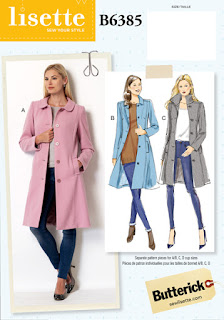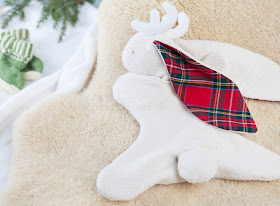I envisioned the gray herringbone coat in Part 1 as my real winter workhorse coat. With its length and warm interlining, it would be the coat I'd reach for on snowy day and it would be great over slacks or skirts. But more often than not, winters here are sort of mild and I'm headed out in jeans or joggers... so I was thinking that my next coat would be a bit more casual and would skip the extra warm lining. I was thinking about a peacoat with military details, maybe in navy. How classic is that? On the other hand, it isn't so creative, and I was already playing it safe with the gray herringbone coat, so perhaps I should be a bit more adventurous with this coat!
As chance has it, someone passed me by wearing an orange coat. The coat they were wearing was obviously RTW in a cheap, overly bright orange, but it sparked my imagination. The color I imagined has a visual impact similar to red, but more earthy. Not halloween orange, but something more towards amber, rust, or burnt orange. I scoured the online fabric stores for coatings in this color family. The pickings were slim... either this wasn't a fashionable color this season, or it was popular and they were all sold out. Finally I found a couple options at Fabric.com, but the one I was most interested in-- a cashmere blend-- had no swatches available. The phone rep was unable to supply a swatch but suggested that I buy yardage, which I would be allowed to return with free return shipping since they hadn't had swatches available. What an odd system. But it ended up working out... when the yardage showed up it was the perfect color and the hand was lovely.
I am also in love with the asymmetric moto jacket trend. I made one several years ago in a blazer, but I'm glad to see that motos are still out there, because I'm not done making them! In fact, Heather at Closet Case Files and Novita at Very Purple Person just recently posted gorgeous asymmetric zip jackets. The closest pattern to my vision is Burdastyle's Larissa jacket which has been on my short list for a long time. But I wanted more of a classic coat profile, so I decided to merge the collars and front zip of the Larissa with Simplicity 2508.
The hybridization of Simplicity 2508 and Burdastyle's Larissa proved to be quite simple. I traced the front panels of both coats and simply overlaid them, creating a hybrid pattern piece. I used Simplicity 2508 in a 16 bust/18 hip and the Larissa in a 42 (the largest size on the non-plus sized pattern), and they fit surprisingly well. I also had to add a tiny bit to the front of the raglan sleeve since the new front of the coat was higher than before. Using the muslin I had already made for 2508, I figured out how long the collar piece needed to be, and the exact placement of the zipper.
I block fused the body of the coat with Pro Weft Supreme Medium and used hair canvas for the collars and front panels of the coat. I decided to go fusible for this coat, and used the fusible tailoring methods described by Anna Zapp in her book Couture tailoring. While I don't mind pad stitching, I've wanted to try this method. I think it worked beautifully! I couldn't find a good online tutorial, so I'll post some pictures of fusible tailoring in a future post.
I'm not so sure that using hair canvas on the front of the coat was such a good idea though. Since I had Zapp out, I was strongly influenced by her interfacing choices, but perhaps this technique is more suited for a shorter coat, or perhaps it just doesn't work that well for this particular fabric. Or maybe the fusible was my downfall. I really don't like the way the hair canvas holds the creases from sitting, and I'm not in love with how it affected the drape of the fabric. If I were to choose again, I would stick with Pro Weft for the coat fronts.
I love the zipper I used... it is a bright brass metal M6 Riri zipper. I ordered it in specially for this coat from Pacific Trimming. When I ordered it, I ordered extra stops and an extra pull so that I could use the excess to make a matching zip pocket.
I went a little nuts with pockets on this coat. In addition to the brass zip breast pocket there are also welt pockets, perfectly placed to be comfortable places to store my hands on a cold day. Since I had the placement dialed in from my Part 1 coat, I used the exact same placement and technique.
 |
| Single welt pockets. |
And there are two "secret" interior pockets. I usually put a pocket in the lining when I make a jacket or coat, but recently it occurred to me that I should put interior pockets in the inside facings. Since the facing is made out of a beefier fabric and fully interfaced, it provides excellent support for the pocket.
 |
| Interior breast pocket (on the opposite side from the exterior one). |
 |
| Interior facing pocket... deceptively deep! |
For the lining, I decided I'd use a piece of silk charmeuse that I've had in my stash for ages. It is just a perfect match for this coat! It is what I'd call a medium weight charmeuse, light but opaque.
After my past bad experiences with silk charmeuse linings in coats, I decided I needed to try a few things to help this lining last a bit longer. The biggest point of failure for past silk linings has been at the seams, so I decided I'd leave generous 1 inch seam allowances. However, this plan was a bit messed up-- somehow I ended up making the lining too small around the armholes and I had to used my extra seam allowances to compensate. So, in a lot of the places that matter the seam allowances are only 1/2 inch.
My other clever plan to add durability to the silk was to underline it. I decided I'd use plain washed muslin for this since it is reasonable strong and light weight. I based each lining piece to its muslin counter part, then serged around the entire thing for good measure. Then I sewed the lining together as usual, treating the silk and muslin underlining as a single piece.
I'm hoping it works out, because I really love this print, and I'll be sad if I'm replacing it in a year!
The sleeve lining is just black rayon bemberg... it hardly shows and is nice and slippery and durable.
I drafted a back facing since it seemed like this coat needed one. Somehow did it wrong twice before it worked out. I still don't know what went wrong the first two times. I was in a bit of a rush so I'm sure that didn't help.
I loved this little tutorial on making a chain hanging loop, and decided to make my own on this coat. The chain I used was described as "11mm x 8mm gold chain" on the Pacific Trimming website and it is perfect for this application. The hanging loops are rayon seam binding that I folded over once for extra durability. The links on the chain were large enough that I didn't bother adding any rings.
I went for the extra long cuffs from Simplicity 2508. I really was hoping I'd convince my machine to sew a nice key hole button hole, but even with a single layer of coating fabric, my Janome choked on the task. So I did some quick fake bound buttonholes. The buttons are more of the horn buttons I ordered from ebay.
I LOVE wearing this coat. It is definitely my favorite thing that I've made, maybe ever! On days that aren't bitter cold, it's the perfect coat to dress up a pair of jeans or to dress down a skirt. And I can't wait to take it traveling-- I'm going to love all of the pockets for stashing plane tickets and passports and the like.















































